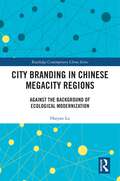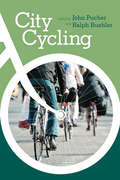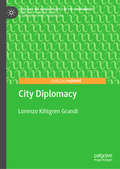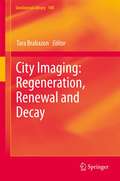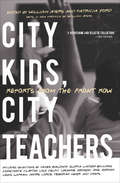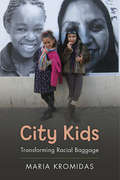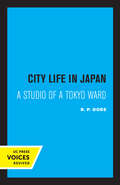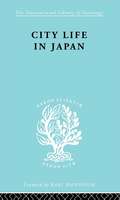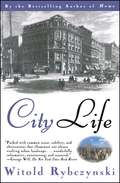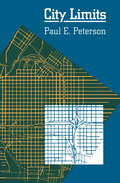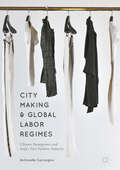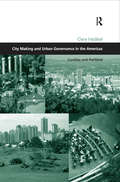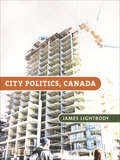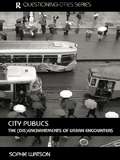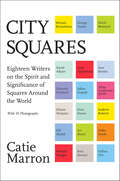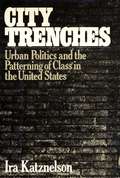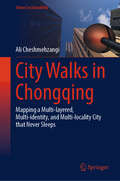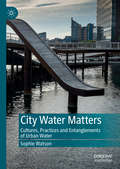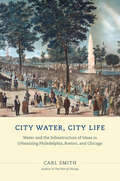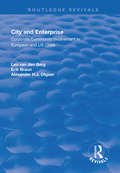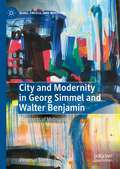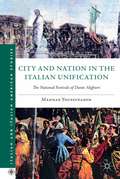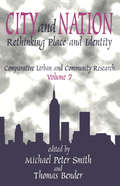- Table View
- List View
City Branding in Chinese Megacity Regions: Against the Background of Ecological Modernization (ISSN)
by Haiyan LuThis book introduces a comprehensive conceptual framework which examines the impact of ecological modernization on city branding, using Chinese megacity regions as examples.Focusing on city branding efforts led by local governments, it delves into practices driven by vertical inspiration, horizontal imitation, and self-reflection. It explores the influence of ecological modernization on different aspects of city branding, such as the branding process, strategy, and governance. The book also compares how ecological modernization affects city branding in terms of local government promotion and individual perceptions. Lastly, it scrutinizes city images associated with ecological modernization initiatives in symbolic urban projects, shedding light on implementation barriers from the perspective of policy network theory.This book will be of huge interest to students and scholars of Chinese urban and environmental studies, urban geography and urban sociology. It will also appeal to policy-makers, practitioners and private companies working in the fields of place promotion, city marketing and branding.
City Cycling (Urban and Industrial Environments)
by John Pucher Ralph BuehlerA guide to today's urban cycling renaissance, with information on cycling's health benefits, safety, bikes and bike equipment, bike lanes, bike sharing, and other topics.Bicycling in cities is booming, for many reasons: health and environmental benefits, time and cost savings, more and better bike lanes and paths, innovative bike sharing programs, and the sheer fun of riding. City Cycling offers a guide to this urban cycling renaissance, with the goal of promoting cycling as sustainable urban transportation available to everyone. It reports on cycling trends and policies in cities in North America, Europe, and Australia, and offers information on such topics as cycling safety, cycling infrastructure provisions including bikeways and bike parking, the wide range of bike designs and bike equipment, integration of cycling with public transportation, and promoting cycling for women and children.City Cycling emphasizes that bicycling should not be limited to those who are highly trained, extremely fit, and daring enough to battle traffic on busy roads. The chapters describe ways to make city cycling feasible, convenient, and safe for commutes to work and school, shopping trips, visits, and other daily transportation needs. The book also offers detailed examinations and illustrations of cycling conditions in different urban environments: small cities (including Davis, California, and Delft, the Netherlands), large cities (including Sydney, Chicago, Toronto and Berlin), and “megacities” (London, New York, Paris, and Tokyo). These chapters offer a closer look at how cities both with and without historical cycling cultures have developed cycling programs over time. The book makes clear that successful promotion of city cycling depends on coordinating infrastructure, programs, and government policies.
City Diplomacy (Cities and the Global Politics of the Environment)
by Lorenzo Kihlgren GrandiThis book presents an accessible overview of the seven key concepts of city diplomacy (development cooperation, peacekeeping, economy, innovation, environment, culture, and migration). The book discusses its scope and challenges, maps the actors involved along with their interaction and offers suggestions for available tools and outcomes. Each chapter includes an analysis of a selection of best practices. The book successfully combines theory with practical evidence and will be an invaluable reference for students and researchers of international relations and urban studies looking for a comprehensive and updated analysis of the multifaceted international action of cities. The book will also be of interest to practitioners and city officials responsible for the design and implementation of impactful diplomatic strategies.
City Imaging: Regeneration, Renewal And Decay (GeoJournal Library #108)
by Tara BrabazonThis book examines the paradoxes, challenges, potential and problems of urban living It understands cities as they are, rather than as they may be marketed or branded. All cities have much in common, yet the differences are important They form the basis of both imaginative policy development and productive experiences of urban life. The phrase 'city imaging' is often used in public discourse, but rarely defined It refers to the ways that particular cities are branded and marketed. It is based on the assumption that urban representations can be transformed to develop tourism and attract businesses and in-demand workers to one city in preference to another. However, such a strategy is imprecise. History, subjectivity, bias and prejudice are difficult to temper to the needs of either economic development or social justice The taste, smell, sounds and architecture of a place all combine to construct the image of a city. For researchers, policy makers, activists and citizens, the challenge is to use or transform this image. The objective of this book is to help the reader define, understand and apply this process After a war on terror, a credit crunch and a recession, cities still do matter. Even as the de-territorialization of the worldwide web enables the free flow of money, music and ideas across national borders, cities remain important. City Imaging: Regeneration, Renewal, Decay surveys the iconography of urbanity and explores what happens when branding is emphasized over living.
City Kids, City Teachers: Reports from the Front Row
by Audre Lorde June Jordan James Baldwin Lisa Delpit Gloria Ladson-Billings Louanne Johnson Deborah Meier Constance Clayton&“City Kids, City Teachers has the potential to create genuine change in the learning, teaching, and administration of urban public schools.&” —Library Journal In more than twenty-five provocative selections, an all-star cast of educators and writers explores the surprising realities of city classrooms from kindergarten through high school. Contributors including Gloria Ladson-Billings, Lisa Delpit, June Jordan, Lewis H. Lapham, Audre Lorde, and Deborah Meier move from the poetic to the practical, celebrating the value of city kids and their teachers. Useful both as a guide and a call to action for anyone who teaches or has taught in the city, it is essential reading for those contemplating teaching in an urban setting and for every parent with children in a city school today. &“Hopeful, helpful discussions of culturally relevant teaching . . . moving illustrations of what urban teaching is all about.&” —Publishers Weekly &“A refreshing and eclectic collection.&” —Alex Kotlowitz, author of There Are No Children Here &“With its upbeat mix of ready-to-share city kids&’ memoirs and classroom strategies, this book is an inspiring resource for veteran teachers, parents, community members, and students.&” —Educational Leadership &“You&’ll feel sad, angry, hopeful, agitated, and inspired.&” —NEA Today
City Kids: Transforming Racial Baggage
by Maria KromidasCosmopolitanism--the genuine appreciation of cultural and racial diversity--is often associated with adult worldliness and sophistication. Yet, as this innovative new book suggests, children growing up in multicultural environments might be the most cosmopolitan group of all. City Kids profiles fifth-graders in one of New York City's most diverse public schools, detailing how they collectively developed a sophisticated understanding of race that challenged many of the stereotypes, myths, and commonplaces they had learned from mainstream American culture. Anthropologist Maria Kromidas spent over a year interviewing and observing these young people both inside and outside the classroom, and she vividly relates their sometimes awkward, often playful attempts to bridge cultural rifts and reimagine racial categories. Kromidas looks at how children learned race in their interactions with each other and with teachers in five different areas--navigating urban space, building friendships, carrying out schoolwork, dealing with the school's disciplinary policies, and enacting sexualities. The children's interactions in these areas contested and reframed race. Even as Kromidas highlights the lively and quirky individuals within this super-diverse group of kids, she presents their communal ethos as a model for convivial living in multiracial settings. By analyzing practices within the classroom, school, and larger community, City Kids offers advice on how to nurture kids' cosmopolitan tendencies, making it a valuable resource for educators, parents, and anyone else who is concerned with America's deep racial divides. Kromidas not only examines how we can teach children about antiracism, but also considers what they might have to teach us.
City Life in Japan: A Study of a Tokyo Ward
by R. P. DoreThis title is part of UC Press's Voices Revived program, which commemorates University of California Press’s mission to seek out and cultivate the brightest minds and give them voice, reach, and impact. Drawing on a backlist dating to 1893, Voices Revived makes high-quality, peer-reviewed scholarship accessible once again using print-on-demand technology. This title was originally published in 1958.
City Life in Japan: A Study of a Tokyo Ward (International Library of Sociology)
by Ron P. DoreIncorporating a new expanded introduction. The continuing relevance of Ron Dore's classic study of Japanese urban life and social structures is widely accepted by urban sociologists and other social scientists concerned with the study of modern Japan.
City Life: Kvale, Interviews 2e + Franklin, City Life + Riessman, Narrative Analysis
by Adrian Franklin'Franklin's ambition in the book is welcome. The scope and historical sweep of analysis, and the attempt to develop arguments at some length, is a productive contrast to the myopic focus of too many analyses. By situating his analysis of the contemporary city in an extensive historical lineage, Franklin is able to draw attention to shifting fashions in urban policy and social theory, and to draw out the consequences of blind spots amidst the often overweening ambition of 'heroic' city planning... the narrative it offers will be... valuable as an introduction to students' - Theory, Culture & Society Read the full review here 'Franklin writes with barely restrained optimism as he emphasizes the excitement, vitality and potential of cities. This advances the idea of city lives as assemblages of 'human and non-human networks of texts, software, culture, behaviour, architecture, trees and gardens'...Franklin uses a wide range of sources in making his case. Historical accounts, search engine statistics and social and cultural theory are all smoothly inte-grated into the narrative' - Sociology Read the full review here Cities are more important as cultural entities than their mere function as dormitories and industrial sites. Yet, the understanding of what makes a city 'alive' and appealing in cultural terms is still hotly contested - why are some cities so much more interesting, popular and successful than others? In this engaging discussion of 'city life' Adrian Franklin takes the reader on a tour of contemporary western cities exploring their historical development and arguing that it is the transformative, ritual and performative qualities of successful cities that makes a difference. Here is a new urban culture characterized by ecological frames of reference; tracking the making of contemporary city life from traditional times, through early modern, machinic and modernised stages of development. Adopting dynamic narrative structures and stories to develop its critical position this book creates a vibrant synthesis of city life from its key components: * leisure and tourism * recreation and play * arts and culture * nature and environment * architecture and public space. Emphasising the importance of experience the book represents the fluid complexity of the city as a living space, an environment and a posthumanist space of transformation. It will be of interest to all those engaging with the difficulties of urban life in sociology, human geography, tourism and cultural studies departments.
City Life: Urban Expectations In A New World
by Witold RybczynskiIn City Life, Witold Rybczynski looks at what we want from cities, how they have evolved, and what accounts for their unique identities. In this vivid description of everything from the early colonial settlements to the advent of the skyscraper to the changes wrought by the automobile, the telephone, the airplane, and telecommuting, Rybczynski reveals how our urban spaces have been shaped by the landscapes and lifestyles of the New World.
City Limits
by Paul E. PetersonThis award-winning book &“skillfully blends economic and political analysis&” to assess the challenges of urban governments (Emmett H. Buell, Jr., American Political Science Review). Winner of the Woodrow Wilson Foundation Award for the best book published in the United States on government, politics, or international affairs Many simply presume that a city&’s politics are like a nation&’s politics, just on a smaller scale. But the nature of the city is different in many respects—it can&’t issue currency, or choose who crosses its borders, make war or make peace. Because of these and other limits, one must view cities in their larger socioeconomic and political contexts. Its place in the nation fundamentally affects the policies a city makes. Rather than focusing exclusively on power structures or competition among diverse groups or urban elites, this book assesses the strengths and shortcomings of how we have previously thought about city politics—and shines new light on how agendas are set, decisions are made, resources are allocated, and power is exercised within cities, as they exist within a federal framework. &“Professor Peterson's analysis is imaginatively conceived and skillfully carried through. [City Limits] will lastingly alter our understanding of urban affairs in America.&”—from the citation by the selection committee for the Woodrow Wilson Foundation Award
City Making and Global Labor Regimes: Chinese Immigrants and Italy's Fast Fashion Industry
by Antonella CeccagnoThis book investigates the success story of the fast fashion industry--mainly owned by Chinese migrants--in Prato, Italy. It outlines how Prato has become the center of a value chain stretching from suppliers in China and Turkey all the way to buyers in Europe. Despite this, a policy attacking Chinese entrepreneurship has been devised and implemented in Prato. This volume analyzes said policy against the crisis of Prato's textile industry. Based on the author's 15 years of fieldwork in Prato, the book sheds light on the entangled processes of city making and the restructuring processes linked to capital accumulation by tackling issues of governance, territory, migration, division of labor, labor mobility, housing, and human rights.
City Making and Urban Governance in the Americas: Curitiba and Portland (Design and the Built Environment)
by Clara IrazábalCities in both North and South America are confronting tremendous challenges in urban growth and management as they enter the new century. Curitiba in Brazil and Portland in Oregon, US are cities that have achieved recognition for exemplary urban planning programmes over the past three decades. As such, they provide particularly useful illustrations of the intense development pressures that many urban areas currently face. This book explores the dynamics of their urban governance, arguing that, in general, there has been a unique synergy derived from the combination of visionary leadership, innovative urban plans and effective citizen involvement. The book argues that, while urban design and architecture are key to the success in making cities livable and in augmenting the global reputations, such sensitive, innovative urban planning and design projects first need to be governed effectively and grounded within the specifics of their local cultures and existing built environments.
City Politics, Canada
by Jim LightbodyCity Politics, Canada is an introduction to the basic politics and core policies of today's city halls. While the book surveys classic discussions and accurately describes municipal institutions in Canada, it also explains why particular policies assume the specific shape they do. James Lightbody draws on over thirty years experience researching and participating in city politics to argue that transparent accountability from local public officials, related to specific policies and the general condition of the community, is an important and desired end for democratic city government. Arguments for change within city politics are insufficient if the result is that everyone has a say but no one is accountable. In following this theme throughout the book, Lightbody examines the various facets of metropolitan politics in a lively and engaging manner, and explains why city politics are important to all Canadians. Provincial agenda setting is viewed through the lens of the urban political landscape, as are the reasons behind the Toronto Megacity (1996) and Montreal's consolidation. Finally, the book expands its discussion to explore the global reach of the urban phenomenon and the impact of world practices on Canada's metropolitan cities. The ultimate hope for this book is that readers, as citizens, will be better able to understand the basic politics and core policies of today's city halls—and will be better equipped to participate effectively in the processes by which those policies are made.
City Publics: The (Dis)enchantments of Urban Encounters (Questioning Cities)
by Sophie WatsonSome cities have grown into mega cities and some into uncontrolled sprawl; others have seen their centres decline with populations moving to the suburbs. In such times, questions of the public realm and public space in cities warrant even greater attention than previously received. Concerned with the borders and boundaries, constraints and limits on accepting, acknowledging and celebrating difference in public, Sophie Watson, through ethnographic studies, interrogates how difference is negotiated and performed. Focusing on spaces where to outside observers tension is relatively absent or invisible, Watson also reveals how the boundaries between the public and private are being negotiated and redrawn, and how public and private spaces are mutually constitutive. Through her investigation of the more ordinary and less dramatic forms of encounter and contestation in the city, Watson is able to conceive an urban public realm and urban public space that is heterogeneous and potentially progressive. With numerous photographs and drawings City Publics not only throws new light on encounters with others in public space, but also destabilizes dominant, sometimes simplistic, universalized accounts and helps us re-imagine urban public space as a site of potentiality, difference, and enchanted encounters.
City Squares: Eighteen Writers on the Spirit and Significance of Squares Around the World
by Catie MarronIn this important collection, eighteen renowned writers, including David Remnick, Zadie Smith, Rebecca Skloot, Rory Stewart, and Adam Gopnik evoke the spirit and history of some of the world’s most recognized and significant city squares, accompanied by illustrations from equally distinguished photographers.Over half of the world’s citizens now live in cities, and this number is rapidly growing. At the heart of these municipalities is the square—the defining urban public space since the dawn of democracy in Ancient Greece. Each square stands for a larger theme in history: cultural, geopolitical, anthropological, or architectural, and each of the eighteen luminary writers has contributed his or her own innate talent, prodigious research, and local knowledge.Divided into three parts: Culture, Geopolitics, History, headlined by Michael Kimmelman, David Remnick, and George Packer, this significant anthology shows the city square in new light. Jehane Noujaim, award-winning filmmaker, takes the reader through her return to Tahrir Square during the 2011 protest; Rory Stewart, diplomat and author, chronicles a square in Kabul which has come and gone several times over five centuries; Ari Shavit describes the dramatic changes of central Tel Aviv’s Rabin Square; Rick Stengel, editor, author, and journalist, recounts the power of Mandela’s choice of the Grand Parade, Cape Town, a huge market square to speak to the world right after his release from twenty-seven years in prison; while award-winning journalist Gillian Tett explores the concept of the virtual square in the age of social media.This collection is an important lesson in history, a portrait of the world we live in today, as well as an exercise in thinking about the future. Evocative and compelling, City Squares will change the way you walk through a city.Contributors include:David Adjaye on Jemma e-Fnna, Marrakech • Anne Applebaum on Red Square, Moscow and Grand Market Square, Krakow • Chrystia Freeland on Euromaiden, Kiev • Adam Gopnik on Place des Vosges, Paris • Alma Guillermoprieto on Zocalo, Mexico City • Jehane Noujaim on Tahrir Square, Cairo • Evan Osnos on Tiananmen Square, Beijing • Andrew Roberts on Residential Squares, London • Elif Shafak on Taksim Square, Istanbul • Rebecca Skloot on American Town Squares • Ari Shavit on Rabin Square, Tel Aviv • Zadie Smith on the grand piazzas of Rome and Venice • Richard Stengel on Market Square, Grand Parade, Cape Town • Rory Stewart on Murad Khane, Kabul • Plus contributions by Gillian Tett, George Packer, David Remnick, and Michael Kimmelman; illustrations and photographs from renowned photographers, including: Thomas Struth, Philip Lorca di Corcia, and Josef Koudelka
City Trenches
by Ira KatznelsonThe urban crisis of the 1960s revived a dormant social activism whose protagonists placed their hoped for radical change and political effectiveness in community action. Ironically, the insurgents chose the local community as their terrain for a political battle that in reality involved a few strictly local issues. They failed to achieve their goals, Ira Katznelson argues, not so much because they had chosen their ground badly but because the deep split of the American political landscape into workplace politics and community politics defeats attempts to address grievances or raise demands that break the rules of bread-and-butter unionism on the one hand or of local politics on the other. A fascinating record of the encounter between today's reformers--the community activists--and the powers they challenge. City Trenches is also a probing analysis of the causes of urban instability. Katznelson anatomizes the unique workings of the American urban system which allow it to contain opposition through "machine" politics and, as a last resort, institutional innovation and co-optation, for example, the authorities' own version of decentralization used in the 1960s as a counter to a "community control." Washington Heights-Inwood, a multi-ethnic working-class community in northern Manhattan, provides the setting for an absorbing close-up view of the historical evolution of local politics: the challenge to the system in the 1960s and its reconstitution in the 1970s.
City Walks in Chongqing: Mapping a Multi-layered, Multi-identity, and Multi-locality City that Never Sleeps (Urban Sustainability)
by Ali CheshmehzangiCity walks enable us to think and feel more intricately, and by living through them – hopefully less ostentatiously - through experiences and relations that genuinely matter. This sort of spatial syntagma is made of many correlations based on knowing what happens in cities, feeling what attributes are important, and articulating a set of relations to develop socio-spatial inter-relations and, ultimately, identities. In a way, &“city walks&” should empower cities to talk penetratingly while we hear, feel, and observe through experiences and thinking. Hence, city walks help the city talk. The City of Chongqing means a lot to me. It is a city that allows you to fall in love with a sense of urbanity for city life and experiences. It is a city that creates a distinguishable set of relations, both transient and abiding in many ways. It is a city with a different tone of heartbeat during the day and the night, a sort of vibration that lives through many arteries at different nodes, settings, and connections. It is a city of multiple networks - different from many other cities - that never sleeps. Most importantly, Chongqing has a unique magnitude of everything that a city can offer. It is a city that can be experienced differently every time you visit it, and you can live through those diminutive experiences via greater connections and expounded senses that exist but have to be experienced first. In this book, Chongqing is studied based on its sophistication of having multiple layers, multiple identities, and multiple localities. Hence, it is structured based on these three crucial aspects, including (urban) values, attributes, experiences, and livelihoods of Chongqing. This book is the first of its kind for a Chinese city and is aimed to reveal a genuine gem while accentuating with pride a city that never sleeps. This should be read and understood by scholars, urban researchers, and urban specialists seeking to develop better cities and communities. &“Just Brilliant! Chongqing has never been portrayed any better than this book does so miraculously&”. - Tian Tang, Independent Researcher, China &“Another unique mapping study by the author; and this time, through sensory and perceptible city walks of a global city – the beautiful city of Chongqing&”. - Aaron Golden, Independent Researcher, UK
City Water Matters: Cultures, Practices and Entanglements of Urban Water
by Sophie WatsonWater is one of the most pressing concerns of our time. This book argues for the importance of water as a cultural object, and as a source of complex meanings and practices in everyday life, embedded in the socio-economics of local water provision. Each chapter aims to capture one element of water’s fluid existence in the world, as material object, cultural representation, as movement, as actor, as practice and as ritual. The book explores the interconnectedness of humans and non-humans, of nature and culture, and the complex entanglements of water in all its many forms; how water constitutes multiple differences and is implicated in relations of power, often invisible, but present nevertheless in the workings of daily life in all its rhythms and forms; and water’s capacity to assemble a multiplicity of publics and constitute new socialities and connections. Cities, and their inhabitants, without water will die, and so will their cultures.
City Water, City Life: Water and the Infrastructure of Ideas in Urbanizing Philadelphia, Boston, and Chicago
by Carl SmithA city is more than a massing of citizens, a layout of buildings and streets, or an arrangement of political, economic, and social institutions. It is also an infrastructure of ideas that are a support for the beliefs, values, and aspirations of the people who created the city. In "City Water, City Life," celebrated historian Carl Smith explores this concept through an insightful examination of the development of the first successful waterworks systems in Philadelphia, Boston, and Chicago between the 1790s and the 1860s. By examining the place of water in the nineteenth-century consciousness, Smith illuminates how city dwellers perceived themselves during the great age of American urbanization. aBut "City Water, City Life" is more than a history of urbanization. aIt is also a refreshing meditation on water as a necessity, as a resource for commerce and industry, and as an essentialOCoand centralOCopart of how we define our civilization.
City and Enterprise: Corporate Community Involvement in European and US Cities (Euricur Series (european Institute For Comparative Urban Research) Ser.)
by Erik Braun Leo Van de BergThis title was first published in 2003. While in the past, corporate community involvement was mainly considered a form of philanthropy, nowadays the argument is gaining credit that corporate community involvement is not only a matter of ethics, but also of self-interest. As companies recognize their interest in the welfare of the city, they may become inclined to invest in some way in that city's welfare. Assuming that the interests of public and private stakeholders tend to converge as companies become aware of their interest in an attractive environment, then corporate community involvement may bring along a new type of public-private partnership, as an instrument of urban regeneration. Bringing together comparative case studies from Amsterdam, Chicago, Leeds, London, Munich, New York, Seattle, St. Louis and The Hague, this considers the potential implications of corporate community involvement for the sustainable development of cities and the creation of cross-sector partnerships. It analyses the involvement of companies in urban challenges in the fields of education, employment, safety, affordable housing and the living environment. It also looks at the efforts made to establish strategic partnership between "enlightened" corporations and public authorities. The book reveals that "pro-active" firms attach much value to investments in their "urban environment" as part of their corporate strategy. But it also shows that cities do not yet take full advantage of these arising opportunities.
City and Environment
by Christopher Boone Modarres AliFor the first time in history, more than half the people of the world live in cities. Comprehending the impact of this widespread urbanization requires an awareness of the complex relationships between cities and natural ecosystems. This innovative book moves beyond the anti-urban lamentations that often dominate today's academic discourse to examine the evolution of cities and to illuminate the roles that humans play in shaping their environments, both natural and constructed. Christopher G. Boone and Ali Modarres argue that understanding the multiple forces of urbanization requires a holistic approach to the interactions of social, cultural, economic, political, and environmental factors. Without casting judgments, City and Environment seeks to engage readers in an exploration of cities from a truly global perspective. Throughout, it illuminates the social-ecological systems of cities not as an academic exercise-although informing academic audiences is one of its goals-but ultimately to help transform cities into livable and ecologically sustainable environments.
City and Modernity in Georg Simmel and Walter Benjamin: Fragments of Metropolis (Marx, Engels, and Marxisms)
by Vincenzo MeleThis book reconstructs and compares the social theories of modernity of Georg Simmel and Walter Benjamin, two classic thinkers in German social thought. The author focuses on five main topics: the historical-sociological method through which they investigate modernity; how are the concepts of history and society possible; the consequences of modern metropolis on the construction of individual subjectivity; the aestheticization of everyday life caused by the expansion of commodity culture; and the female culture as a counter-power to the domination of masculine objective culture. In the decades since Simmel and Benjamin, urban reality has undergone profound changes and we may even question the very existence of the subject of analysis: what is the city, the metropolis in today’s context of globalization and capital flows? Simmel’s and Benjamin’s metropolis has thus become an “endless city," beyond the physical and geographical confines of urban reality.
City and Nation in the Italian Unification: The National Festivals of Dante Alighieri (Italian and Italian American Studies)
by Mahnaz YousefzadehThis study of the first national festival of modern Italy historically reconstructs the event, using a mass of un-catalogued and unpublished documents left by the organizers, which positions the Centenary as a platform upon which an alternative definition of Italian national identity emerged.
City and Nation: Rethinking Place and Identity (Comparative Urban and Community Research #Vol. 7)
by Thomas Bender Michael Peter SmithThis compendium offers a textured historical and comparative examination of the significance of locality or "place," and the role of urban representations and spatial practices in defining national identities. Drawing upon a wide range of disciplines - from literature to architecture and planning, sociology, and history - these essays problematize the dynamic between the local and the national, the cultural and the material, revealing the complex interplay of social forces by which place is constituted and contributes to the social construction of national identity in Asia, Latin America, and the United States. These essays explore the dialogue between past and present, local and national identities in the making of "modern" places. Contributions range from an assessment of historical discourses on the relationship between modernity and heritage in turn-of-the-century Suzhou to the social construction of San Antonio's Market Square as a contested presencing of the city's Mexican past. Case studies of the socio-spatial restructuring of Penang and Jakarta show how place-making from above by modernizing states is articulated with a claims-making politics of class and ethnic difference from below. An examination of nineteenth-century Central America reveals a case of local grassroots formation not only of national identity but national institutions. Finally, a close examination of Latin American literature at the end of the nineteenth century reveals the importance of a fantastic reversal of Balzac's dystopian vision of Parisian cosmo-politanism in defining the place of Latin America and the possibilities of importing urban modernity.
